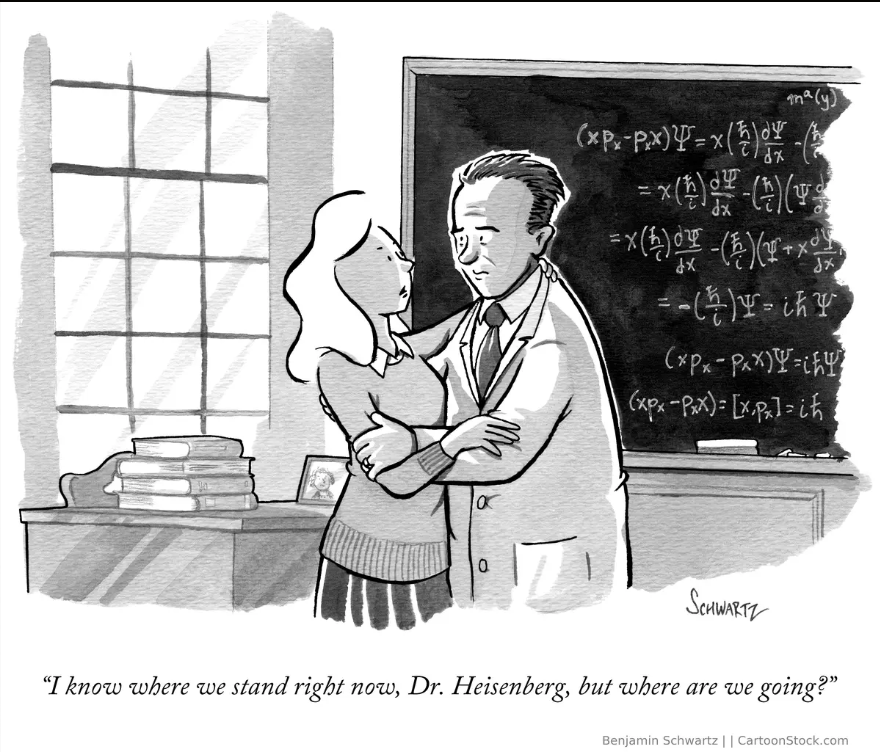Could the formulas on the blackboard be from a genuine quantum mechanical derivation? Maybe even Dr. H’s Uncertainty Principle? And the caption almost fits one of its usual ordinary-language formulations — that’s probably the actual point of the gag.

It’s quantum mechanics, but not the Uncertainty Principle. I don’t have enough knowledge, but it’s clearly something to do with Schrodinger’s wave equation. The visible parts are well-formed and could be correct. Dividing h-bar by i is not what I expect, but by line 4 it’s negative so the i can go back to the top.
The caption is certainly funny, though. You can know position or velocity, but not both.
I’d say “no”. I don’t think that stuff gets done this way any more; all the proofs I’ve seen are nothing like the four-blackboards-long equations of movies/TV (and this).
And the Uncertainty Principle isn’t a formula thing anyway, I don’t think: it’s merely an observation that by observing something, you affect it. Kinda meta…
Yes, this is, in fact, a derivation of the Heisenberg Uncertainty Principle.
I am way too rusty in quantum mechanics to go through the derivation step-by-step. But the important part is the last line:
(xp – px) = iℏ
(He actually has p-sub-x, but I am not going to try to coerse Word Press to display subscripts.) x is position and p is momentum. We cannot measure both at the same time with unlimited precision.
In ordinary algebra, we would expect xp – px = 0. In QM, iℏ is a very small, imaginary number, but it is not zero. I am too rusty to remeber how that translates into uncertainty, but the non-commutation of x and p is the original formal statement of the Uncertainty Principle.
The caption seems to be alluding to their relationship.
Certainly, Grawlix, on one level. But there is also a way of explaining the Uncertainty Principle in terms of a tradeoff (inverse proportionality) between the precision an object’s position can be known and the precision its momentum can be known. Which is roughly what she is saying. (As I now see Jajizi is explaining better.)
Jajizi says … but I am not going to try to coerse Word Press to display subscripts
Hey, you did a fine job getting an h-bar!
My favourite uncertainty principle joke:
An electron is driving down the highway and gets pulled over by a police officer.
“Do you realise how fast you were going, sir?” asks the police officer.
“No,” replies the electron.
“105 miles per hour.”
“Thanks a lot,” replies the electron. “Now I’m lost.”
Yeah, it’s showing that when you go through the full math, position x and momentum along that axis do not commute. In the first line, x and p-sub-x are operators acting on the wave function Psi.
The importance of not commuting is that you can never really measure two different things simultaneously, there has to be an order. If the things commute (xp-px=0) then it doesn’t matter which order you do things in, so you should be able to measure both of them arbitrarily well. But since order does matter, whatever you do to measure the first thing better will tend to mess up the second thing.
(Indeterminacy, incorrectly translated as uncertainty, doesn’t apply to ALL pairs of things. Just those that don’t commute. You can measure position and time arbitrarily well together, as xt-tx=0.)
If they don’t commute, how do they get home from work every day? 🙄
Stan (7): Funny!
Dana K (9): Consider your comment liked.